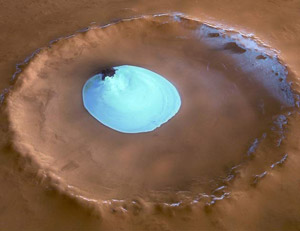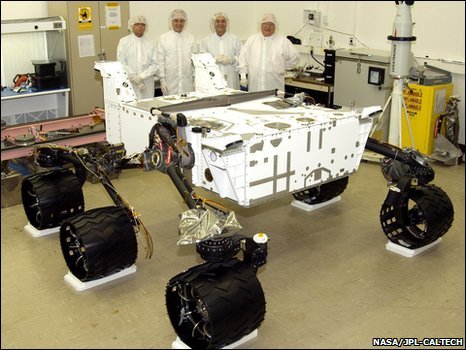More evidence for past life on Mars
Carbonate Mineral Rocks

New evidence has recently been revealed that strengthens the theory that life once existed on the red planet. Earlier this week it was reported by NASA that the Mars Exploration Robot "Spirit" has found martian rocks rich in carbonate minerals, which suggests there was much more water in Mars past than previously thought.
The original find was way back in 2005 but dust had stopped one of the instruments from functioning and so they have had to calibrate to remove the effect of dust. While small amounts of carbonate minerals have been found on the Red Planet previously this is the first time the mineral has been discovered on a large scale.
Not only does this suggest that large amounts of water were present, but also that Mars was also warmer with a dense carbon dioxide atmosphere (indicating a greenhouse gas effect) and even more importantly the water would have been "chemically neutral" which is an encouraging environment for the formation of life.
Huge Seas covered Mars
Even more exciting for the past existence of life on Mars is the discovery of large sedimentary deposits in the Hellas Planitia area suggesting that there was a large sea present between 3.5 and 4.5 billion years ago. The Geological mapping project suggests that the sedimentary deposits were formed through the erosion and movement of rock and soil from the highlands to a standing body of water.
The Hellas Planitia is a 2 000 km wide impact crater and is the largest on Mars, some scientists now believe that conditions on Mars were much more favourable for the evolution of life on the Red Planet than on Earth during the same time period.
The Mars Laboratory
According to NASA scientists we are still just at the beginnings of exploring our neighbourhood planet and the next stage of this exploration comes in the form of a $2 billion dollar science Laboratory called MLS (also known as Curiosity) that will be lowered onto the surface of Mars in 2013 and will "revolutionise investigations in science on other planets".

This project will also lay the foundations for future missions including one that could return a sample from Mars as the mission involves managing to land a metric tonne onto the planet. The lab itself is a six wheeled robot the size of a small car with a mass of scientific instruments including still and video cameras, imagers, x-ray spectrometers (measuring chemical elements), a "chemcam", a Radiation detector (for measuring radiation for possible human visitors), a weather monitoring station and even a "Dynamic Albedo of Neurons" which looks for neurons escaping the planets surface.
Curiosity's main mission is to look for signs of past and present habitation.
The project was originally planned for launch in 2009 but various problems with the build has put this date back to 2011.
News Archives
- August 2024
- July 2023
- April 2023
- February 2023
- September 2022
- March 2022
- February 2022
- July 2021
- June 2021
- April 2021
- March 2021
- January 2021
- October 2020
- September 2020
- June 2020
- March 2020
- May 2019
- January 2019
- November 2018
- January 2016
- September 2015
- August 2015
- July 2015
- June 2015
- May 2015
- April 2015
- March 2015
- January 2015
- October 2014
- June 2014
- April 2014
- March 2014
- February 2014
- January 2014
- December 2013
- November 2013
- October 2013
- September 2013
- June 2013
- May 2013
- April 2013
- March 2013
- January 2013
- December 2012
- November 2012
- August 2012
- July 2012
- June 2012
- May 2012
- April 2012
- March 2012
- February 2012
- January 2012
- December 2011
- November 2011
- October 2011
- September 2011
- August 2011
- July 2011
- June 2011
- May 2011
- April 2011
- March 2011
- February 2011
- January 2011
- December 2010
- November 2010
- October 2010
- September 2010
- August 2010
- July 2010
- June 2010
- May 2010
- April 2010
- March 2010
- February 2010
- January 2010
- December 2009
- November 2009
- October 2009
- September 2009
- August 2009
- July 2009
- June 2009
- May 2009
- April 2009
- March 2009
- February 2009
- January 2009
- December 2008
- November 2008
- October 2008
- September 2008
